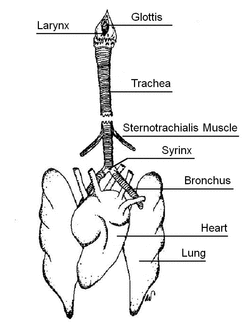Body Weight: 3.7 - 6.2 kg (~7 - 13 lb)
Head & Body Length: 56 - 62 cm (~22 - 24.5 in)
Tail Length: 28 - 49 cm (~11 - 19 in)
General
-
Differences between the 2 species are minor
-
Ailurus styani is larger overall and has a slightly bigger skull – more robust teeth. Inflated frontal sinuses.
-
Slight pelage differences (see section on Pelage below)
-
-
White cheeks and muzzle with dark eye patches
-
Ears:
-
Erect, triangular-shaped – white inside with low red patch
-
Middle ear cavity is small (may have less auditory capacity)
-
-
Tufts of facial whiskers (vibrissae) around mouth
-
Striped bushy tail provides balance during arboreal locomotion
-
Round, relatively massive head
-
Teeth large and flattened: Unlike other carnivores, molars have elaborate crown pattern – modified for chewing bamboo.
-
Chewing muscles enlarged
-
Enlarged salivary glands (common in omnivorous carnivores)
-
-
Larynx is like other procyonids
-
Unique digestive system
-
Simple digestive tract lacks microbes that facilitate digestion of plant material
-
Digestive tract is relatively short (much like other carnivores) but is unusual in herbivores
-
Single-chambered stomach; most herbivores have multi-chambered stomachs
-
-
Fore and hind limbs are of similar length
-
Paw pads are covered with hair (adapted for walking on snow/cold ground)
-
Small glands within paw pads secrete a colorless, odorless fluid of uncertain function (Roberts & Gittleman 1984)
-
Semi-retractable sharp claws used for climbing
-
Sesamoid bone of wrist (thumb) is greatly enlarged but not as big as that of Giant panda, which has forepaws that manipulate and pull apart bamboo leaves and stalks (Roberts 1981)
-
-
Scent-marking anal glands secrete dark, pungent fluid
-
8 mammary glands reduced or absent
Pelage
-
Ailurus fulgens (Himalaya): Deep red coat, lightened on rump. White face mask more pronounced.
-
Ailurus styani (China): Longer winter coat. Coat has more black. Tail stripes more distinct.
Sexual Dimorphism
-
No sexual dimorphism in size or color
Breathing
YES THEY HAVE LUNGS, just like human!



-
White cheeks and muzzle with dark eye patches
-
Ears:
-
Erect, triangular-shaped – white inside with low red patch
-
Middle ear cavity is small (may have less auditory capacity)
-
-
Tufts of facial whiskers (vibrissae) around mouth
-
Striped bushy tail provides balance during arboreal locomotion
-
Round, relatively massive head
-
Teeth large and flattened: Unlike other carnivores, molars have elaborate crown pattern – modified for chewing bamboo.
-
Chewing muscles enlarged
-
Enlarged salivary glands (common in omnivorous carnivores)
-
-
Larynx is like other procyonids
-
Unique digestive system
-
Simple digestive tract lacks microbes that facilitate digestion of plant material
-
Digestive tract is relatively short (much like other carnivores) but is unusual in herbivores
-
Single-chambered stomach; most herbivores have multi-chambered stomachs
-
-
Fore and hind limbs are of similar length
-
Paw pads are covered with hair (adapted for walking on snow/cold ground)
-
Small glands within paw pads secrete a colorless, odorless fluid of uncertain function (Roberts & Gittleman 1984)
-
Semi-retractable sharp claws used for climbing
-
Sesamoid bone of wrist (thumb) is greatly enlarged but not as big as that of Giant panda, which has forepaws that manipulate and pull apart bamboo leaves and stalks (Roberts 1981)
-
-
Scent-marking anal glands secrete dark, pungent fluid
-
8 mammary glands reduced or absent
Pelage
-
Ailurus fulgens (Himalaya): Deep red coat, lightened on rump. White face mask more pronounced.
-
Ailurus styani (China): Longer winter coat. Coat has more black. Tail stripes more distinct.
Sexual Dimorphism
-
No sexual dimorphism in size or color
Breathing
YES THEY HAVE LUNGS, just like human!
Lifespan
Red pandas may live as long as 22 years. They show symptoms of age at around 12 to 14 years. While females do not breed after age 12, males continue to be reproductively capable.





